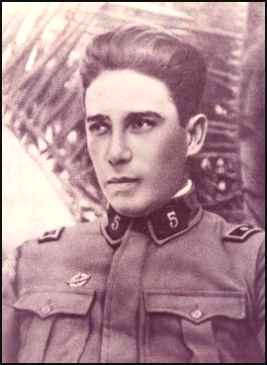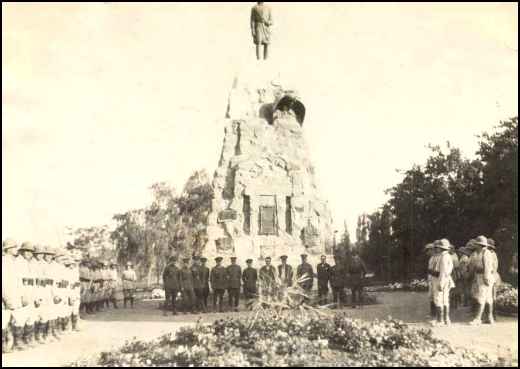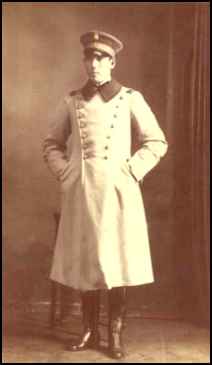
1891-1919 |
 |
Courtesy of Eloy Martín |
|
via email from Eloy Martín, Matienzo was born in the province of Tucumán the 9 of April of 1891. He entered the Military School of the Nation the 9 of March of 1909 withdrawing with the Second lieutenant degree of the communication troop the 31 of December of 1910. His promotion of debit was Nº 35, between his comrades there was an important amount of civilian and military aviators: Manuel Felix Origone (first victim of the military aviation), Luis Cenobio Candelaria (first in crossing the mountain range in it airplane), Oscar Lozano, Antonio Parodi, Vicente Andrada and Julio Garci'a Fernandez, Gregorio Jesus Rafael Terneyro Bravo and Jose William Rosasco. In 1916 he entered the Military aviation school of Aviation. The 24 of March of 1917 obtained the title of Flying Pilot Nº 111, the 12 of September obtained the title of Superior Military pilot and the 24 of June of 1918 the title of Military pilot (Military Bulletin Nº 5058) like part of 4º Course of Aviators of the Military aviation school. The 23 of May, on board of the biplane Voisin 5 THE ONE of the Military aviation school, successful made with Engineer Edmundo Lucius a raid between the localities of the Palomar and San Miguel de Tucumán with scales in Rosary, Rafaela, the Real Band, Sayana and Santiago of the Matting. Next to the military rated officers Zanni and Parodi it conformed the original nucleus of the fighter aircraft of the Argentine Army and projected the crossing of The $andes by Mendoza to Santiago of Chile. For it three biplanes conformed an integrated squadron: 5 Ansaldo SVA Nº 1 Sartorelli, 10 Ansaldo SVA Nº 1 Giovanardi and the Nieuport 28C1 N6338, whose crossing was predicted for day 28 of May of 1919. That Matienzo day decided to be first in making specific the attempt of crossing and took off of the aerodrome of the Tamarinds passing away when falling with its airplane between 28 and 29 of May of 1919 when trying the crossing in flight of The $andes from Mendoza after hurrying in the mountain range with the Nieuport 28C1; its corpse was found the 18 of November in front of the House of the Mines, distant to 20 km of the place of the Cuevas. The 29 of November of 1922, during a stage of the Raid the Northwest made by the Army, the Squadron of Observation to control of the CAP Av Thousands Oscar Lozano when arriving at Tucumán went directly to the local cemetery and carried out I fly over in company of the provincial Governor to pay tribute to its memory. |
 |
Courtesy of Eloy Martín |
|
The 28 of May of 1927 the monument erected in his was inaugurated in the city of San Miguel de Tucumán memoria. The 14 of June of 1923, the definitive nonsuit in summary 394/919 was arranged, instructed in the occasion of its death (Military Bulletin Nº 6491, 1ª Part). The 28 of May of 1927 the erected monument was inaugurated in the city of San Miguel de Tucumán in his memoria. The 3 of February of 1950 one patrols, that left from Uspallata the 21 of January integrated by the Subof Ay Enrique Svars, the Sarg Ay of Army Victor Manuel Bringa, the Cbo My de Aeronáutica Oscar Enrique Funes, the Cbo of Army Rómulo Moreno and the soldiers Angel Lopez, Juan Calderón, Ceferino Biglia, Epifanio Jofre, Dionisio Carballo, Urquiza Pillar and Benito Tardivio found in a gorge the rest of the Nieuport 28C1 used the 28 of May of 1919 by Matienzo. The biplane was found to 4500 ms of altitude and 150 ms of the border line to the north of the Opening of the Contrabandistas. The 21 of January of 1970, was declared by Precursory and Meritorious Law of the Argentina Aeronautics (Public Aeronautical Bulletin Nº 2100). The 29 of May of 1989, in the occasion of 70º anniversary of its disappearance the National Company Post office and Telegraphs, Encotel emits an allusive postmark in the postal office of Field of Mayo. |
 |
Courtesy of Eloy Martín |
email Ramón Guillermo Gil, 5-17-09 Within a few days will mark 90 years of an event that shook our country and Mendoza. This is the Benjamín Matienzo death of an airman who, along with his companions, undertook the daring voyage crossing the Andes. A madman and his Flying Machine Lieutenant Benjamin Matienzo settled in Mendoza shortly after graduating from the Military Aviation School, but at the end of 1918 went to serve in the No. 5 Battalion of Engineers. For some time, Matienzo and his comrades, Captain Pedro Zanni-one of the first to try and Lieutenant Antonio Parodi, were proposed to cross the Andes, a dream for many pilots at the time. After preliminary studies, everything was ready to perform the feat. A dream that lasted a little It was in that month of May 1919 that the three airmen were faced with a very important challenge: crossing the Andes a height of 6000 meters. At 6.40 in the morning, the pilots with their flying machine lifted from the airfield Tamarinds. Shortly after returning captain Pedro Zanni, for agotársele fuel, making later Parodi lieutenant, who suffered a malfunction in the engine. Spent several hours with no news of the flight had Matienzo, but the slowness of communications at that time justified the silence. However, already beginning to hint at some concern regarding the so that could have played the brave pilot, despite the unlimited confidence which had regarding their skill, experience and serenity. The public anxiety was growing with the passage of time and became more evident the following day. The accident and the operation Faced with the prospect of an accident, the military stressed that special committees toured Las Cuevas, Amarillo Zanjón Tupungato and because recent data that had put the flight apparatus moving in a northwest Las Cuevas. Chilean solidarity, always present in events like these, was immediate and numerous committees military initiated in the recognition of Juncal transcordillerana, Rio Blanco, and Los Caracoles Andes. The action was completed by land air flights serving thorough scan on both sides Andean mountain range. The search efforts did not yield any sign. Intense time of snow, which had plagued the area, hampering the operations and did jeopardize the human security. expectant Mendoza Disparate versions started running in the streets. Each day that passed gave rise to the popular invention circulating from mouth to mouth and attached to this or that outcome research, but invariably sources of information is responsible for misleading. Gradually, the newspapers moved their news headlines on the subject. In the end, there was silence around the event, fatally imposed by the evolution of new developments. However, there was neglect, then leaked almost daily on the street or at a family gathering the phrase stir up memories. A search again He spent the winter and the mountains off their mantle of snow by the action of the thaw. In mid-November 1919, the Deputy Commissioner of Las Cuevas took the idea of finding the Pilot missing. On November 17 the modest expedition left the command of Deputy Commissioner Pujadas. This, without finding anything returned. The next day continued the search but without results. On the morning of Wednesday 18 November 1919, the group continued the search. Headed by the Deputy Commissioner that patrol Pujadas, the saved threads South American Telegraph Company Juan Hernandez, the corporal and officer Teófilo Morales Second Zelaya. It was 9 am when they came to a shack in the first set of mines, owned by a Chilean Lobos called in the valley of Las Cuevas about 14 miles from that place. There the expedition made a stop for rest and eat. Seated, began to raise some scenario where it would have fallen on the unfortunate aviator. Half an hour later, the group departed to the north. At least sixty meters away, Chilean Juan Hernandez shouted to his companions: "There is Matienzo. It's body rested in Matienzo appeared as a projection of rock. All were surprised. We found a Matienzo On hearing the cry of Hernandez, Pujadas observed the body lying on the floor leaning over a large stone, with your legs slightly shrunk and arms outstretched to either side. The body was dressed in a khaki suit over a dark white knitting. The garment, torn birds of prey, had left uncovered the rib cage. You could see that the gaps had a wore black pants and boots, had woolen underwear. The picture was quite disrespectful. Although snow could feel the stench of decomposing bodies. Inmediatamentese saw that his face was bare. Your teeth, firmly fastened, and neck and viscera eaten by condors. His hands burned by the snow were a black color on the back and his fingers. With a strange feeling of sorrow, noting that the group continued deterioration in the left ring finger was a ring gold with the initials BM, which highlights a red background. On the left side of the body was found a black crayon. The condition of the shoes attracted much Pujadas and several focus group because they were peeled. It is assumed that Matienzo had walked a large stretch since the fall of his airplane. For some twenty meters from the body was found the helmet, a helmet and remnants of clothing carried by the wind. An important finding made Pujadas Joaquin to locate the gun. Of the six two bullets missing. This puzzled the researchers. Could guess that could have been killed by the unbearable situation that faced Matienzo, but this hypothesis was completely disregarded. The news ran fast and Mendoza had resounding echo throughout the country and abroad. Comment public was inflamed and was again forced the issue everywhere. Thirty years later, the military expedition of the NCO and Bring svars was found that the aircraft Matienzo was closed and that tragic history. To access more information, content and opinions of our readers go to: www.losandes.com.ar Copyright LOSANDES 2008. All rights reserved. |
|
|
|
If you have any more information on this pioneer aviator please contact me. E-mail to Ralph Cooper |


|